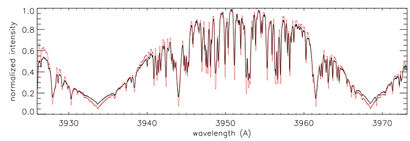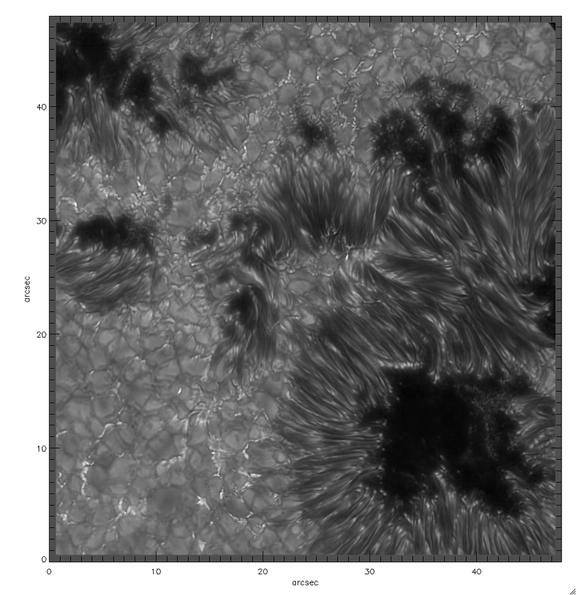Instrumente am VTT
Echelle-Spektrograf
The Echelle spectrograph has a spectral resolution of >750 000 and is a powerful tool for diagnostic spectroscopy. Up to three wavelength regions can be selected by the predisperser and can be observed simultaneously. Three gratings with different blaze angles are available to optimize the light throughput. Data acquisition is performed with up to three of the following CCDs: PCO 1, PCO 2 & Sensicam (more details on CCDs below). On the slit (focal plane of telescope), the image scale is 4.49 arcsec/mm. The image scale in the focal plane of the spectrograph is 8.98 arcsec/mm.
Data calibration packages (sophisticated flat fielding routines) to produce science-ready data is available.
Low Disperion Spectrograph

A second spectrograph at the VTT has a spectral resolution of about 100 000 and a much wider spectral range compared to the Echelle spectrograph, about 4.5 nm. The figure shows the Ca II H and K lines with 4072 pixels and 11 mA per pixel. There is a special grating for this purpose which replaces the standard predisperser grating of the Echelle. Data acquisition is performed with a single PCO camera at the position of the predisperser focus. The slit length corresponds to 90 arcsec and fits well onto the PCO camera with 0.0849 arcsec/px.
LARS Absolute Reference Spectrograph
LARS (Laser Absolute Reference Spectrograph) is an instrument for precision solar spectroscopy in applications that do not require high spatial or temporal resolution but a high signal to noise ratio and an accurate wavelength calibration. It is based on the existing VTT echelle spectrograph (R > 750 000) extended with a single mode fiber feed (SMFF) and a laser frequency comb (LFC) based wavelength calibration system. The fiber feed picks up light from the VTT focal plane with a field of view of three arcseconds on the sky. It enables a high spectral purity with low instrumental straylight and superior flatfield correction with a tungsten flatfield lamp. With the LFC an absolute wavelength calibration of better than one meter per second is possible.
Triple Etalon Solar Spectrograph TESOS
TESOS performs 2D spectroscopy. Three Fabry-Perot interferometer (etalons) are tuned to scan through a solar absorption line. For each wavelength, 2D images of a narrow band (spectral resolution of 280 000) and of a broad band image are recorded. Approximately 100 wavelength positions can be recorded within 40 seconds. A data reduction software package is available. Data calibration routines are available.
Relevant publication:
Tritschler, Schmidt, Langhans & Kentischer, 2002, Solar Physics 211, 17: ”High-resolution solar spectroscopy with TESOS - Upgrade from a double to a triple system”.
Kentischer, Schmidt, Sigwarth & von Uexkuell, 1998, A&A 340, 569: ”TESOS, a double Fabry-Perot instrument for solar spectrocopy”.
von der Lühe & Kentischer, 2000, A&AS 146, 499: ”High spatial resolution performance of a triple Fabry-Perot filtergraph”.
A manual as to how to use TESOS/VIP is available in the download section in the right colum.
Visible Imaging Polarimeter TESOS/VIP
TESOS can be extended to operate as a polarimeter to measure the four Stokes parameter at wavelengths between 600 and 660 nm. It can also be used as a simple V-polarimeter. VIP was developed as a collaboration between the Instituto de Astrofísica de Andalucía and KIS.
Relevant publication:
Beck, Bellot Rubio, Kentischer, Tritschler & del Toro Iniesta, 2010, A&A 520, A115:
”Two-dimensional solar spectropolarimetry with the KIS/IAA Visible Imaging Polarimeter ”.
HELioseismological Large Regions Interferometric DEvice HELLRIDE
HELLRIDE is a new Fabry-Pérot based spectrometer specifically designed to record the Doppler shifts of a large number of solar spectral lines in a quasi-simultaneous and multitarget mode. It will be used to carry out helioseismic investigations of the solar atmosphere and to analyse footpoint flows of coronal loops. Solar flares may be a further target in a future upgraded mode.
Optics Laboratory
The VTT offers an optical lab where users can temporarily install their own instrumental setup. The optical bench is fed with solar light via an adjustable 45-degree mirror in the first floor (in the same way as TESOS is fed with light).
Cameras or Imaging and Spectroscopy
Three CCDs are available: PCO 1, PCO 2, and Sensicam. PCO2 has a wedged window and is suited for observations with high spectral resolution.
For performing imaging at diffraction limited spatial resolution, the Sensicam privides high cadence. This CCD cameras can be operated in the speckle-burst mode or in the frame-selection mode. For performing the speckle reconstruction, a user friendly-speckle reconstruction code KISIP (Kiepenheuer Institut Speckle Imaging Package, extended Knox-Thompson and Triple Correlation methods) available. For information and observing requests please contact Sergio González Manrique.
Relevant publication:
- Wöger & v.d. Lühe 2006: ”KISIP: a software package for speckle interferometry of adaptive optics corrected solar data”. Advanced Software and Control for Astronomy II. Edited by Bridger, Alan; Radziwill, Nicole M. Proceedings of the SPIE, Volume 7019, pp. 70191E-70191E-8 (2008).
- Mikurda, von der Lühe, & Wöger, 2003, AN supplement 324, p112: ”Solar Imaging with an Extended Knox- Thompson Technique”.
